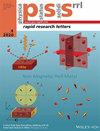Why is the band gap of GaP indirect while that of GaAs and GaN are direct?
IF 2.5
4区 物理与天体物理
Q3 MATERIALS SCIENCE, MULTIDISCIPLINARY
引用次数: 0
Abstract
Many III-V semiconductors possess direct band gaps and are thus widely applied in optoelectronics. Although GaN (either in wurtzite phase or zinc blende phase), GaAs and GaSb are well-known direct gap semiconductors, GaP exhibits an indirect band gap nevertheless. This seems mysterious when considering that, P is between N and As among Group-VA elements and GaN has a direct gap even in the zinc blende structure. In this work, we analyze the generic rule of energy gaps in GaN, GaP and GaAs of the zinc blende phase, and study the trends of gap variation concerning the lattice constant and anion electronegativity. It is demonstrated that a compressed compound among the zinc blende III-V semiconductors is more likely to show an indirect band gap, while a tensed compound tends to possess a direct band gap. While GaP actually manifests a normal behavior, the reason why GaN surprisingly has a direct gap is analyzed through examining and perturbing its valence band as well as conduction band. It turns out that the conduction band electron shows a non-negligible probability to emerge near the N cores. The attractive nucleus potential pulls down the conduction band more strongly at Γ, which is in principle further supported through an analysis of the Kronig-Penney model. The difference between GaP and GaN in this respect is also analyzed in detail.为什么 GaP 的带隙是间接的,而 GaAs 和 GaN 的带隙是直接的?
许多 III-V 族半导体都具有直接带隙,因此被广泛应用于光电领域。尽管氮化镓(无论是钨锌相还是锌掺杂相)、砷化镓和锑化镓都是众所周知的直接带隙半导体,但磷化镓却表现出间接带隙。考虑到 P 在 VA 族元素中介于 N 和 As 之间,而氮化镓即使在锌混合物结构中也有直接带隙,这种现象似乎很神秘。在这项研究中,我们分析了锌混晶相的氮化镓、磷化镓和砷化镓中能隙的一般规律,并研究了与晶格常数和阴离子电负性有关的能隙变化趋势。研究表明,在锌混合物 III-V 半导体中,压缩化合物更有可能显示间接带隙,而张开化合物则倾向于拥有直接带隙。GaP 实际上表现出正常的行为,而 GaN 则通过检查和扰动其价带和导带,分析了为什么 GaN 会出人意料地出现直接带隙。结果发现,导带电子以不可忽略的概率出现在 N 核附近。有吸引力的原子核势在Γ处更强烈地拉低了导带,通过对克罗尼格-彭尼模型的分析,原则上进一步证实了这一点。我们还详细分析了氮化镓和磷化镓在这方面的区别。
本文章由计算机程序翻译,如有差异,请以英文原文为准。
求助全文
约1分钟内获得全文
求助全文
来源期刊

Physica Status Solidi-Rapid Research Letters
物理-材料科学:综合
CiteScore
5.20
自引率
3.60%
发文量
208
审稿时长
1.4 months
期刊介绍:
Physica status solidi (RRL) - Rapid Research Letters was designed to offer extremely fast publication times and is currently one of the fastest double peer-reviewed publication media in solid state and materials physics. Average times are 11 days from submission to first editorial decision, and 12 days from acceptance to online publication. It communicates important findings with a high degree of novelty and need for express publication, as well as other results of immediate interest to the solid-state physics and materials science community. Published Letters require approval by at least two independent reviewers.
The journal covers topics such as preparation, structure and simulation of advanced materials, theoretical and experimental investigations of the atomistic and electronic structure, optical, magnetic, superconducting, ferroelectric and other properties of solids, nanostructures and low-dimensional systems as well as device applications. Rapid Research Letters particularly invites papers from interdisciplinary and emerging new areas of research.
 求助内容:
求助内容: 应助结果提醒方式:
应助结果提醒方式:


